Jules’ 7 Picture Books Kicks
 September 2nd, 2007 by jules
September 2nd, 2007 by jules
Here are my 7 Kicks for this week, my Part Two, if you will, to today’s 7 Kicks post. These are seven picture books that I read this week that made me happy in one way or another, all in the name of kicking off Picture Book Week here at 7-Imp . . .
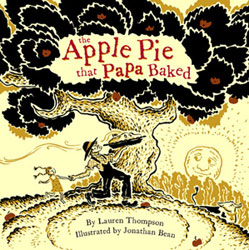
by Lauren Thompson
Illustrated by Jonathan Bean
Simon & Schuster
July 2007
(personal copy)
May I pretty please just send you to Betsy Bird’s wonderfully detailed review of this title (parts one and two)? She covers the all-around brilliance of this picture book, Lauren Thompson’s original cumulative tale about a young girl’s delight in the apple pie (“warm and sweet”) her farmer father has baked for her — starting with the apples, “juicy and sweet,” that he plucks from the tree on their farm — with the little girl’s help after she wakes in the morning and sees him trotting off with a ladder and a basket for the apples. As Betsy pointed out:
{I}n spite of the fact that a cumulative form can only go backwards (you begin with the end product and then work yourself back to its proto-beginnings) Bean found a way to go forward in time visually. You may begin with the image of a pie, but then the book doubles back and you see Papa picking apples, baking the pie, and running about with his daughter. The words themselves, however, have become cosmic. They go so far as to present the very world itself (“blooming with life”) and then pare it down and down and down until all you’re left with is that single apple pie. So while Thompson’s story grows larger and more universal with every consecutive line, Bean gets smaller and more personal. The combination makes for an eclectic bit of storytelling.
Whew. That’s a big chunk of her detailed review, but she nails there a few of the many joys of the book: its narrative structure; the spare, precise language; and the fascinating interplay of text and illustrations here that make this a title you’ll want to read and re-read many times over. And, as Jonathan Bean points out in an illustrator’s note, each illustration is composed of three separate drawings, done on separate sheets of vellum paper, with only the colors red, yellow, and black, having scanned the colors into his computer. Whew, a 21st-century illustrator’s approach to bringing a book to life that really and truly harkens back to some of the classics of children’s lit, honoring them yet still maintaining its own originality, as Betsy also pointed out: “Bean credits Wanda Gág and Virginia Lee Burton as his influences and by gum if this book doesn’t look like what would happen if you squeezed The Little House and Millions of Cats together in a vise. The story has a timeless quality to it,” she wrote.
Dare I say I haven’t seen a more perfect merging of text and illustrations this year (thus far)? And, of all the lovely things about this book, my favorite — hands down — is the simple wonder of the world around us that it celebrates: the “This is the world, blooming with life” spread will almost take your breath away and is a study in composition and line. I also got a bit squealy over the book’s hardcover illustration of the apple pie under the book jacket; if you have a library copy with the taped-down book jacket, alas and alack you won’t be able to see this. Nice detail. Rather rare to see anymore, no? A beautifully-designed and well-crafted book all around. But really, just go read Fuse’s great review if you want more details. And just don’t miss this title. I can’t wait to see what Jonathan Bean brings us next.
{If you didn’t already make it to this post from today’s 7 Kicks post, then head on over there to see a spread from this book which Jonathan has shared with 7-Imp and our readers today. Thanks again, Jonathan!} . . .
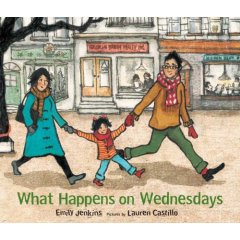
by Emily Jenkins
Illustrated by Lauren Castillo
Farrar, Straus and Giroux
July 2007
(review copy)
What happens on Wednesdays for a preschooler? Well, if you think that she will tell you in a linear and typically-adult fashion (at 8 a.m., I do this, and by noon, I’m doing that), you’d be wrong. She tells us as only a preschooler can, noting with the sharp-as-a-tack observation skills of children the rituals of her day and bringing to vivid life both the Brooklyn neighborhood in which she lives and her family’s idiosyncratic observances. She notes how the day begins (Wednesdays are not kissing days, by the way): “When the clock says six, we wake up Daddy. Which can take a long time.” Heh. She notes what Mommy does, what Daddy does, what she eats, and how the rest of the neighborhood, including the cat in the shop across the street, wakes. Her daddy takes her to school with a pit stop at the local dog park to have breakfast with friends and her buddy, Zoya, and the other dogs who frequent the place. She briefly tells us what Wednesdays at school are like and then how she spends the afternoon and early evening with her parents back at home. As the publisher will tell you, it’s like reading the “sensory map” of a child, the sounds, tastes, smells, and sights of her day. Children will be instantly drawn to the young protagonist’s voice. And this is Castillo’s first illustrated book, as I understand it, and her mixed-media illustrations here are engaging, possessing much detail and a texture which make you feel as if you’re right there with this girl and her family on this no-kissing day, taking in all the sights and sounds. I have to agree with the Kirkus reviewer who wrote (in the starred review) that there is a definite Margot Zemach feel to Castillo’s work (“with thick smudgy lines and a wintertime palette that celebrates the leafless beauty and energy of this intimate patch of Brooklyn”), and it’s an altogether great thing. And this is an altogether great book. Emily Jenkins scores again, and judging by this one title alone, we seem to have a great new talent in the picture book landscape with Castillo (plus, her web site is fun).

by Laura Ljungkvist
(or, alternately, this site for Ms. Ljungkvist)
Viking Juvenile
May 2007
(library copy)
So, this is a follow-up to last year’s engaging Follow the Line (also Viking Juvenile), but I never saw that title. See how ignorance can be bliss sometimes? After enjoying this sequel of sorts, in which we follow the line through the house, I was doubly excited to see I can get another title like this at my local library. If you missed Follow the Line last year — like I did — then here’s the scoop: A solid black, rather Etch-A-Sketch line goes barreling along through each spread, curving and looping and swooping around, propelling us forward as it outlines the objects you see in the many rooms of a home (go to the book’s site to see what I mean). Of course, that one Ljungkvist-never-picks-her-pen-up line cannot create all the objects, though it goes pretty far and is fun to follow, so Ljungkvist throws in other objects and shapes and forms in her very retro (think 1950s) geometric-art style. First you see the kitchen, and then in the next spread you’re in the refrigerator. Next, you see the basement, and then you’re in the toolbox, jam-packed with tools. Then, master bedroom. Next spread: the very detailed big closet. You get the idea. And you don’t just follow the line, but you get to count and name letters and try to spy things, as Ljungkvist throws in a few questions for the reader: “Can you find the cherries that fell out of the bag?” in the fridge? (And, just for fun, “What would you choose for a snack?” and “What would you wear to a fancy party?” in the big closet — oh, I covet that swanky retro blue checkered dress!). She also includes an object in each spread which does not belong, and you better bet that children will absolutely squeal to be the first to spot the, say, hand saw in the master bedroom closet, which really belongs in the toolbox, or the piece of cheese in the treasure chest in the attic, which really belongs in the fridge. And, at the end of your journey, she asks if you spotted the teeeee-niny mouse. So, you’re having fun with this book to begin with, trying to follow this line and marvel at how many shapes she managed to outline with one line, and then she’s throwing in these questions which get children to think — yes, learn while having fun: identifying colors, counting, recognizing letters, finding matching elements, and more. It’s a fabulous one-on-one lap book for you and your favorite wee one.
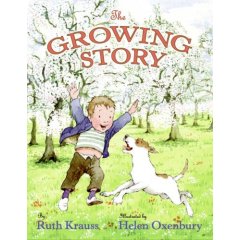
by Ruth Krauss
Illustrated by Helen Oxenbury
HarperCollins
Originally published in 1947 with illustrations by Phyllis Rowand;
Newly-illustrated edition: May ’07
(library copy)
HELEN OXENBURY! HELEN OXENBURY! I’m chanting here. Love her books. This is a newly-illustrated edition of a 1947 Ruth Krauss title about a young boy who wonders when he’s going to grow up already. “A boy and a puppy and some chicks were all very little” it opens — with Krauss’ legendary, direct, to-the-point, do-not-pass-go child appeal, which, par for the course for her, continues all throughout the tale. Summer’s coming, too, and this boy notices that the grass, the trees, the flowers, and even his puppy are growing. His hard-workin’ mama (no papa in sight, but fear not, this mama knows how to take care of business, bustling about doing the gardening and pear-picking and child-rearing and housework and everything else in between, I’m sure) . . . where was I? Oh yes, she assures him that he’ll grow, too. They fold up his “warm woolen pants” and coat and store them ’til next year, as the seasons of the year pass and he notes that everything else — but him — seems to be growing. Finally, when winter arrives again, he is delighted to see his pants are too tight, the legs are too short, and the sleeves of his coat are too short as well, jumping for joy outside, and then — on the final spread — executing an exuberant handstand and then throwing his arms up with a big, goofy, wonderful grin, his pants about to fall down the entire time (since they won’t even snap in the front, you see). The cheer is infectious. “Ebullient,” wrote the Booklist review. Oxenbury’s light-infused illustrations radiate warmth and tenderness, what she always manages to do so well without crossing the line into cloying. You just have to see her orchard tree spread, too (you can get a hint from the cover up there). Loveliness. I’ll say it again: HELEN OXENBURY!! HELEN OXENBURY!!

Life of Riley
by Colin Thompson and Amy Lissiat
Kane/Miller
Originally published in Australia
in May 2005
First American Edition: September 2007
(review copy)
Yup, I’m going to direct you once again to another of Betsy Bird’s reviews. ‘Cause, well, I think she nails this title in her analysis of it (with some extras thrown in, including a note about the cigarette-smokin’ cherub in the book) over at her SLJ blog. Really, great and thorough review there. What do I think? I think I’d agree with Betsy that this is primarily a title for older picture book readers; yes, as she opines, teens would really dig it. I can also see it getting passed around with great enthusiasm amongst adults, especially the inspiration-seeking ones (it’s a message-heavy title). I also agree that this 2006 winner of Picture Book of the Year from The Children’s Book Council of Australia is not like any other picture book you’ll see this year. “Everyone wants to live forever” the book opens. “They want to be happy and healthy. Some of these things are actually quite difficult, but some of them are really easy, which might seem surprising because most people hardly manage any of them. At least not all of the time. None of this bothered Riley.” Riley, you see immediately, is a rat. A purple rat who was “always happy, even when he was asleep.” His family loves him; he’s got fruit and slugs to eat (“People, of course, want more than that, which is a shame because it’s about all you need, apart from a cup of tea and some toast and maybe not the slug”). Thus begins the tale of one very needy human, Norman, and Riley, who is happy with less. You know how I said it’s message-heavy? Well, it’s really all about the message (the book comes with its own logo: “Release your inner Riley”): Be happy with less (oh, and never compare your life to an animal’s: “You will only end up feeling depressed”). People, you see, do things they don’t want to do and hang out with people they don’t really like, etc. etc. – and we live a long time, on average. Riley spends all his time “eating his favorite food in his favorite place with his favorite friends” — and he only lives a short time. The book’s heavy on the hyphenation (people want to be “taller-shorter-thinner-here-but-much-bigger-there-curly-straight-younger-older-less-spotty-moustache-smooth-skin-golden-sun-tan-gorgeous-irresistible-not-bald-and-famous-in-a-painting”) and the Photoshopping art via a Mac. But, as Betsy pointed out, those Photoshop-heavy moments are used primarily to point out the rather shallow, superficial elements of Norman’s world — or what he wants his world to be. And it’s done well. Again, not like any other picture book I’ve seen this year, that’s for sure. An interesting, odd little book. Thought-provoking. As Betsy put it, it’s a “messy, fun, thoroughly enjoyable concoction.” Word.

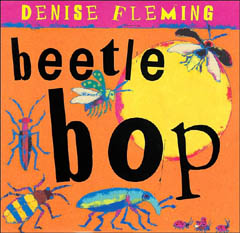
Margaret K. McElderry Books; January 2007; (library copy)
Ah, the Steve Jenkins love continues, this Jenkins-illustrated title having been published back at the beginning of this year, but I’m just now getting to it. In Birdsongs, Franco not only brings us the musical warbles of various birds — from the red-headed woodpecker (“tat tat”) to the robin (“tut tut”) and many others — but she also brings us a backwards counting book as her means of organizing this engaging subject matter. The book opens with the sunrise, and then we meet that red-headed woodpecker, looking for breakfast bugs with his ten “tat”s. And then we keep counting down with a mourning dove (“coo”), house sparrow (“chip”), white gull (“eeyah”), black-capped chickadee (“dee”), mallard (“qua”), crow (“caw”), robin (“tut”), thrasher (“chuck”), and hummingbird (“tzik”) — coming round full-circle at the end to the setting sun and a mockingbird, who “copies all of the songs and calls she has heard during the day.” Clever way to close the book, and there is a “feathery facts” spread at the very end. Needless to say, this makes for a great read-aloud, inviting all kinds of audience participation; children will enjoy trying out the birds’ trills. Jenkins’ collage depictions of the birds are beautiful: “Jenkins’s gorgeous, boldly graphic collages make the birds seem at once familiar and magical; in the startling close-ups and dramatic framings, the winged creatures seem to fly off the page” (Publishers Weekly). There are some appealing moments of metaphor: “More and more chickadees join her until the tree looks like a candelabra” and “{the hummingbird’s} wings look like a helicopter propeller,” and all in all, I’d say if you’re already a bird-lover or even if you’re new to their calls and cries, the book will interest and enthrall.
And if you’re a fan of Denise Fleming, well, you’re in luck, because her new title about the bopping of beetles in your backyard completely delivers in all the wonderful ways that Fleming never fails to wow readers: The book sings with her rhythmic, alliterative, onomatopoeic text (“Buzzing beetles, humming beetles, steadily drumming beetles”) and her bold, bright, bustling illustrations — this time created by “pouring colored cotton fiber through hand-cut stencils,” a note in the book says. She brings us a wide array of beetles in varying colors and shapes and sizes and stripes — all very busy, some glowing, some flashing, some “constantly crashing,” some hiding in the cracks, some trying not to be seen at all. And, yes, they dance across the pages (in more ways than one); hence, the title: “Beetles flip, Beetles flop, Beetles fly, Beetles
. . . bop!” On the final page, she gives a bit of scientific information about the beetle, appealing directly to the child reader, “What kinds of beetles live near you?” It’s a great book for elementary science courses (as the Publishers Weekly review points out, children who pore over the illustrations will learn a lot about beetle behavior as well as the beetle’s unfortunate place in the food chain), but language arts and art teachers in an elementary setting can go far with this book, too — what with Fleming’s rhythmic, buoyant text and her eye-popping compositions.
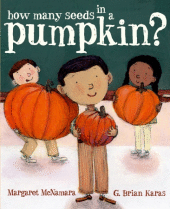
by Margaret McNamara
Illustrated by G. Brian Karas
Schwartz & Wade
July 2007
(review copy)
Okay, this post is long enough, but we must make room for the latest G. Brian Karas-illustrated title, my seventh kick here — How Many Seeds in a Pumpkin?, which is just good timing, what with October and all the requisite pumpkins comin’ up . . . oh, I just about can’t wait to carve one with my wee girls. And Karas has created these illustrations on a very Autumn-esque palette, too, which is lovely . . . Elementary math teachers and librarians, take note: This is a counting title. The children in this classroom (Karas depicts a very diverse group of students here) divide into groups to count the seeds in a small, medium, and large pumpkin after having guessed which one will contain the most. The students count by twos, fives, and then tens (in spreads which make it easy for students reading the book — or listening to it — to count along) and are surprised to see that the smallest pumpkin has the most seeds. But the charm of this book is that McNamara takes you beyond just counting to a less-can-be-more theme. The smallest child in the class, Charlie — who quietly suffers always being last in line when the class lines up by size — comes to see that “Small things can have a lot going on inside them.” It’s a nice moment — not too much, not too lesson-y, but just enough to make you want to stand up and cheer for Charlie. To boot, “Charlie’s Pumpkin Facts” are included at the book’s close. An enjoyable read.
That’s it . . . those are my seven kicks to kick off Picture Book Week here at 7-Imp. Anyone still with me? If you are and you read any of these titles, please come back and let me know what you think! Until then . . .

I LOVE, love, love How Many Seeds in a Pumpkin? and am right with you on What Happens on Wednesdays. Your list of 7 is great!
There are people who don’t like picture books? Say it isn’t so!
I must check a few of these out — Apple Pie, Wednesday, and the Life of Riley stand out to me, but you sold the hell out of all of them.
Jules,
Thanks for this great post! I included a link to it at Wild Rose Reader. I’ve been tempted to buy HOW MANY SEEDS IN A PUMPKIN? and THE APPLE PIE THAT PAPA BAKED. I really like BIRDSONGS…and I love THE GROWING STORY. Oxenbury really breathes new life into an old classic, doesn’t she?
I wrote a review of THE GROWING STORY for WRR that includes suggestions for two poetry books written by Lilian Moore that would be great to share along with the book.
http://wildrosereader.blogspot.com/2007/06/picture-book-review-growing-story.html
Enjoy the holiday. The weather has been gorgeous here in Massachusetts!!!
Thanks, all.
Elaine, thanks for that link. I’m looking forward to reading it. You’re always such a great poetry and picture book source for me.
How Many Seeds in a Pumpkin? is so cute and fun… a wonderful book!
[…] in a Pumpkin by Margaret McNamara, released by Schwartz & Wade Books in July (which I reviewed here), and Tippy-Tippy-Tippy, Hide! by Candace Fleming, published by Ginee Seo Books (Atheneum) in […]